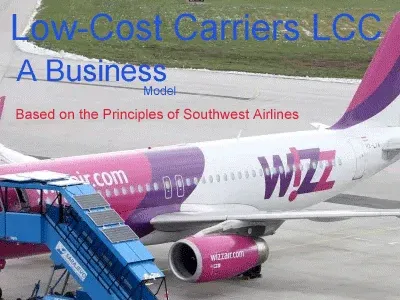The Low-Cost Carrier business model was developed in 1970 by Pacific Southwest Airlines (American domestic carrier), it allows the U.S. airline industry to implement the low-cost carrier business model for the first time in the world of the aviation business.
Herb Kelleher1 who formulated the low-cost carrier Business model says: "If you get passengers to their destinations when they want, on time, at the lowest fares possible and make sure they have a good time on board, they will come back and fly your airlines again and again". Southwest American domestic airline is the airline that has opened a new era in transportation and managed to gain a different perspective on the air transport sector.
Herb Kelleher1 who formulated the low-cost carrier Business model says: "If you get passengers to their destinations when they want, on time, at the lowest fares possible and make sure they have a good time on board, they will come back and fly your airlines again and again". Southwest American domestic airline is the airline that has opened a new era in transportation and managed to gain a different perspective on the air transport sector.
Note 1- Co-founder and CEO of Southwest Airlines
In the late 1990s, some European airlines adopted a business model based on the principles of Southwest Airlines, expanding them by adding new elements.
{getToc} $title={Table of Contents}
What is a Low-Cost Carrier?
A low-cost carrier is an airline that offers low airfares by eliminating all unnecessary services [ all kinds of free in-flight services, such as in-flight entertainment (IFE) and free meals to minimize their costs].
The low-cost carrier business model is very simple: operate at the lowest possible cost and sell seats at low rates such that they stimulate demand and achieve high load factors [High-density seating leads to lower unit costs, as fixed costs can be attributed to more seats and passengers].
Also, LCCs focus on cost reduction to implement a price leadership strategy in the markets which they serve.
Furthermore, a low cost carrier’s fleet size and fleet structure have a substantial impact on its operating costs. LCCs’ costs are therefore minimized by operating a single-type aircraft fleet. The use of a young and homogenous fleet of medium-sized aircraft (usually Boeing 737-700/800 or Airbus 320/1 aircraft) normally results in a reduction of fuel, maintenance, staff costs, and – if large orders at discounted prices are placed – capital costs.
Low-Cost Airlines Business Models
Low-cost airlines business model describes an architecture for how a firm creates and delivers value to customers and the mechanisms employed to capture a share of that value. It's a matched set of elements encompassing the flows of costs, revenues, and profits.From the definitions of the business model concept, it can be said that airline business models demonstrate how airlines operate and create value for their stakeholders.
Airlines have a diversity of business models and do not act as a monolithic group. Each airline has a unique combination of business characteristics that helps to differentiate it from its competitors.
Low-Cost Carriers, by applying a cost focus strategy and mixed strategy, try to keep costs under control and minimize all cost items. Although the business models of the individual airlines may vary, many common characteristics can generate an overall picture of what the low-cost business model is and what low-cost carriers represent in the blow.
The low-cost carrier business model has transformed the airline market, making flying cheaper than driving, and opening significant new market opportunities.
The best low-cost carriers 2021
To answer this question, I referred to the Sky Trax [ World Airline Awards] for the World’s Best Low-Cost Airlines 2021.
- AirAsia
- Southwest Airlines
- Scoot
- Vueling Airlines
- IndiGo
- EasyJet [ According to AirlineRatings it is on the list of top 10 safest low-cost airlines for 2022]
- Jetstar Airways
- Ryanair [ According to Airline Ratings it is on the list of top 10 safest low-cost airlines for 2022]
- Jetstar Asia
- Flynas
- Peach
- Eurowings
- Norwegian
- Air Canada rouge
- Jet2.com
- SpiceJet
- JetSmart
- Spring Airlines
- Air Arabia
- Wizz Air [ According to AirlineRatings it is on the list of top 10 safest low-cost airlines for 2022]
Summary
According to ICAO, in 2015, the global aviation network carried 3.5 billion passengers on 34 million scheduled departures (preliminary figures). By 2030, current projections suggest those numbers will nearly double.
Low-Cost Carriers have played a major role in this extraordinary expansion of aviation over the past quarter century, and there is every expectation that they will continue to do so. Low-cost carriers carried 984 million passengers in 2015, which was 28 percent of the world's total scheduled passengers.
This marked a 10 percent increase compared to 2014, which means Low-Cost Carriers experienced a passenger growth rate that was about one and a half times the rate of the world's total average passenger growth.
No matter where you’re going in the world, low-cost airlines offer significantly cheaper flights, while others (traditional airlines) focus more on customer service than they do on offering price breaks. But some people would rather find cheap flights and great flight deals than worry about the level of customer service they’re getting.
Low-cost airlines are safe, for example, the world's oldest budget airline, America's Southwest, has never had a crash in 40 years of operation – that's over 12 million flights.
Low-cost airlines should not focus on cutting costs at the expense of safety at all times.
References:
1- ICAO
2- The Evolution of low-cost carriers in Australia, By Panarat SRISAENG, Glenn S. BAXTER, Graham WILD, School of Aerospace, Mechanical and Manufacturing Engineering, RMIT University.
3- Economization Methods Used by Low-Cost Airlines – An Overview,by Dominik Punda , Małgorzata Jasiulewicz-Kaczmarek , Jacek Dziwulski, European Research Studies Journal Volume XXIV, Special Issue 2, 2021
4- World’s Best Low-Cost Airlines 2021, SKY Trax.

